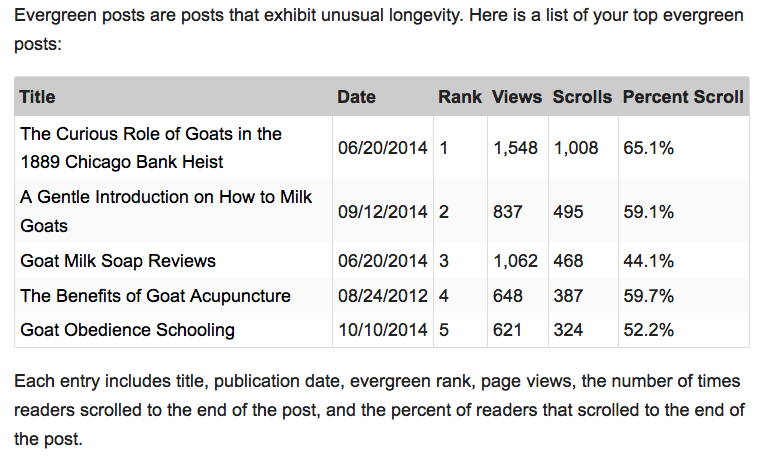Starting Monday night, Contextly clients will be getting a new analytics report in their inbox, with more data about what readers are doing on the site, what stories are resonating, and how users are interacting with Contextly’s recommendation modules.
We’re excited because this is a big leap for us and our customers. We built an entirely new reporting infrastructure that’s capturing more data in a more reliable way. That allows us to report back to sites with data that helps them do their jobs better. And we’ll be able to more quickly add new reporting to support our awesome clients.
Here are the five biggest changes in the new reports:
- Reports on Demand: Individuals can now get rolling reports – a daily, weekly,monthly or annual one — sent to them with a single click. These reports are intended to provide you data in (almost) real-time. This allows writers, editors and publishers to make informed decisions throughout the day.
- Scroll Rate: We’re now able to detect when readers finish individual posts. We think this new functionality forms a solid basis for measuring reader engagement.
It allows us to do things like calculate the percentage of users that scrolled to the bottom of a post, calculate the percentage of users that scroll to the bottom of all posts by a particular author, etc. - Evergreen Reporting: Our recommendation system identifies and promotes “Evergreen” stories – older stories that keep giving value to readers long after they’ve fallen off the homepage. These can change over time, as things like holiday content starts to bubble up, so we want sites to be able to see their top evergreens.
Sites can see what’s giving long-term value to readers. Sites can then decide to update these stories, promote them again on social or the homepage, or figure out how to make more stories like them.
- Reporting on Types of Recommendations: We use a number of types of recommendations to provide ways for readers to dive into a topic or explore a site. These include Related (algorithmically decided), Curation (related chosen by sites), Evergreen, Popular, and Personalization.
For enterprise clients, these can also include special sections or Related Videos and/or Products. The new reports break down how often these types are used, and which resonate with your readers. This is intended to give you a better sense of what Contextly does. - Core Audience: Many sites have little idea of the size of their return readers. We’ve defined a new metric called Core Audience, which is the number of readers who have read 3 or more stories in the last 30 days. We then also keep track of how many of these Core Readers come back in a given period.
For more details on the reports, check out this separate blog post from our CTO, Ben Autrey.
How we got here:
When Contextly started, we wanted to help sites understand the benefit from Contextly and give them a high-level view of their site in order to make their work easier.
Contextly users often tell us they love our reports, and we realized that our reports themselves were a way to help publishers.
Over the past year, we spent a lot of time adding new features. Our feature set grew much larger than what we were measuring with our analytics system.
It became clear that we needed to do a major rebuild of our analytics system in order to report on the new features we had built. We took this opportunity to build a whole new system. It not only reports on the performance of all our new features, but it’s also more extensible and allows us to have checks that the data coming into the system is correct.
In many ways, Contextly Reports is different than the previous system, but it was built with the same objectives in mind: help publishers understand how Contextly is helping them and give them a time-saving tool to make their daily work easier.
We’re excited about the new reports, and have lots of ideas about how we can get sites even more useful data to help them serve their readers.
So, take a look, let us know what you think of the new reports, and feel free to ask for more.
As always, send us feedback, criticism, gifs and ideas at info@contextly.com.
